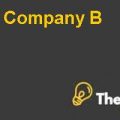Market Expansion at CMS Electronics Case Study Help
Bargaining Power of supplier
The supplier’s bargaining power force falls with a medium and low range in the market due to the fact that the company has developed positive as well as strong relationshipswith the end suppliers of the most significant component, without which the product could not be manufactured.
Contrariwise, since the company has been heavily depending upon the sub-outsource partner, there is medium dependency risk as it embedded to the CMS credibility itself while serving its customers. Furthermore, the trends & potential in the automotive industry have been emerging with the passage of time.Thesuppliers in the market could be benefited from the opportunity of switching to another company, hence posing a high bargaining extent on the company. On the other standpoint, the new suppliers have been entering into the market due to which CMS could exploit the opportunity of working with another supplier, thereby posing strong force on existing or current suppliers with regards to maintaining the efficiency and cost.
Extent of rivalry
There is a high extent of rivalry force in the market, because OEM players have been engaged in technology and automotive product outsourcing from other companies in a similar market. In addition to this, the OEMs have been prolonging the substantive brand equity as well as market presence.Other competitors in the marketare supposed to opt for the suppliers who are as same as giant OEMs for achieving the technological expertise & similar success.
Threat of substitution
In the market, there is a high threat of substitution force because of the availability of alternative solutions that are beingofferedby other suppliers as well asthe same kind of products being offered by the competitors. Moreover, the discovery of the new breakthrough models and the evolution of technology are witnessed in the competitive market.The substitution threat is eminent.
The threat of New Entrant
There is a highthreat of new entrants force because of the reason that OEMs have been shifting to markets of Asia while offering some chances to suppliers is Asia to access the market in Europe. Also, various low barriers of entry have been imposed by the government, hence attracting and allowing small suppliers to move into theEuropean market. Additionally, the setup cost is relatively high, but the tradeoff between the opportunity & the cost of setup are also high, which in turn enables small market players to pursue their entrance in the market.
Recommendation
Moving into the Chinese market would lead to some drawbacks and benefits to the company, which are as follows:
Benefits
- It would enable the company to attract the customers that are looking forwards to move into the Chinese market and avail of the cost effective services in the future ahead.
- It would also allow the company to sustain or retain its client base thatis seeking to shift to the Chinese market through offering services under one roof and maintaining its client ratio.
- This might allow the company to enjoy the first mover advantage to enter into the market of China and effectively tap & exploit the opportunities
- CMS Electronics through expansion would be able to reach to new customer base & follow the old ones, hence meeting the increasing demand.
- It would enjoy new knowledge, experience, contacts etcetera. The capacity of production would increase, thus representing a positive outcome
Drawbacks
- To setup the company in the emerging market i.e. China would be costly & it could require high investment amount with uncertain results or outcomes.
- The expansion into the Chinese market might expose CSM Company to the challenges &external threats in dealing with market.Although, the company has an immense knowledge and understanding about managing the expansion operation, but the Chinese market is entirely different from that of European, hence crating a state of risk.
Considering the trends and challenges in the Chinese market, the company should move into the Chinese market as it would allow the company to manage demand and client in an effective manner and allows it to retain its client base in the existing markets, as it would be creating a surge of word of mouth & might lead to attractthe new & potential customers that might be considering to enter into markets of China. (Walleck, 2011).
Tapping the Chinese market would enable the company to unleash the market with emerging and new trends& strong economic factors. Additionally, it would allow the company topursue the strategy of product development under different SBUS. By doing so, the company would be able to add profits, hence making it sustainable in China. Due to the product development strategy, the OEMS would find the company more attractive who are planning to pursue the operations in China. This kind of pre-hand entry would make the company one of the potential suppliers to opt for services. The labor &resources are cheap in the Chinese market.(Vishwanath, 2005)
Additionally, developing a backward integration strategy & including sequential practices under one roof, might reduce the time lags and quality issues due to diverge, suppliers, capability &availability of resources.By doing so, the company would become able to defend its market position to the existing customers & might leverage its quality service for the limited portfolio. (Deimler, 2011).
Action Plan
Short-term plan
In the initial operation phase, thecompany should pursue the research surveys in China in order to gain knowledge about changes, trends & external factors in the consumer markets & behaviors. If the company does sothen it would be able to analyze the strategy type (customization or standardization) to be used in China. Also, the imitation legal policies and intellectual property rights issues would be studied in order to minimize the risk. This would enable the company to strategically decide the marketentrancestrategy accordingly. The government stability and changes would be critically assessed ion order to pursue the business initiation in China.
Middle term plan
In the mid time period, the company is recommendedto enter intothe Chinese market for the purpose of pursuing operation for German clients. A deep market analysis would be completed to mitigate the intellectual property rights risk. Also, the deep understanding & knowledge of Chinese language and culture would be developed in order to attract the Japanese or local Chinese OEMs to work with thecompany, hence eventually scaling up the level of offering and gaining additional revenues.
The market survey would also be completed in this phase to focus and checkthe impact of the external factors and stability of the business & to improve the long term operation’s sustainability. The company could do so bycomparing the economic activities and political precursors during the time period of 5 years. Also, more OEMS from European as well as Hungarian markets would be easily accessed & approached to work with CMS Company. This would bring desirable benefits to the company as the players in Europe as well as Hungary are considering to move towardstheAsian market with the nearby supplier to improve the supply chain efficiency and to save cost.
Long term Strategy
In the long term action plan, increasing the size of the factory and developing new SBUS or increasing operations in the European and Chinese marketsare recommended to the company. The company could also reach the Indian market for business initiation as it is one of the developingor growing markets which has support from government initiatives. This would provide an easy access to the Asian markets & would enable the company to increase the major share of the market substantially.............................
This is just a sample partical work. Please place the order on the website to get your own originally done case solution.











